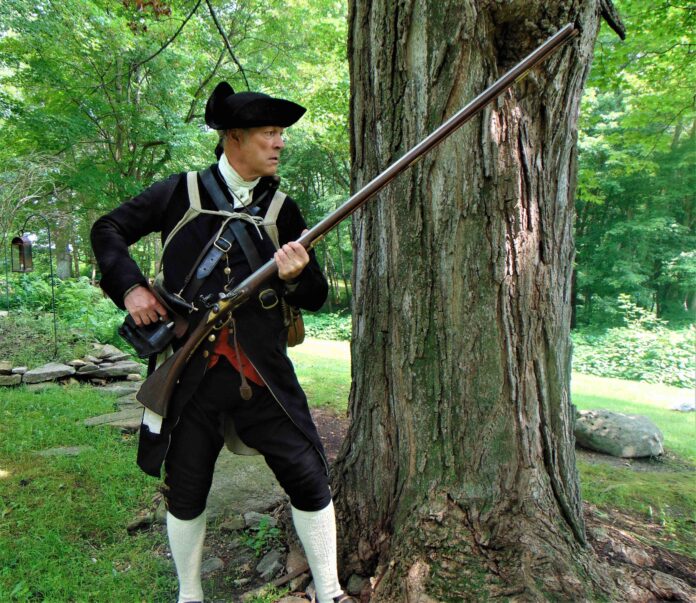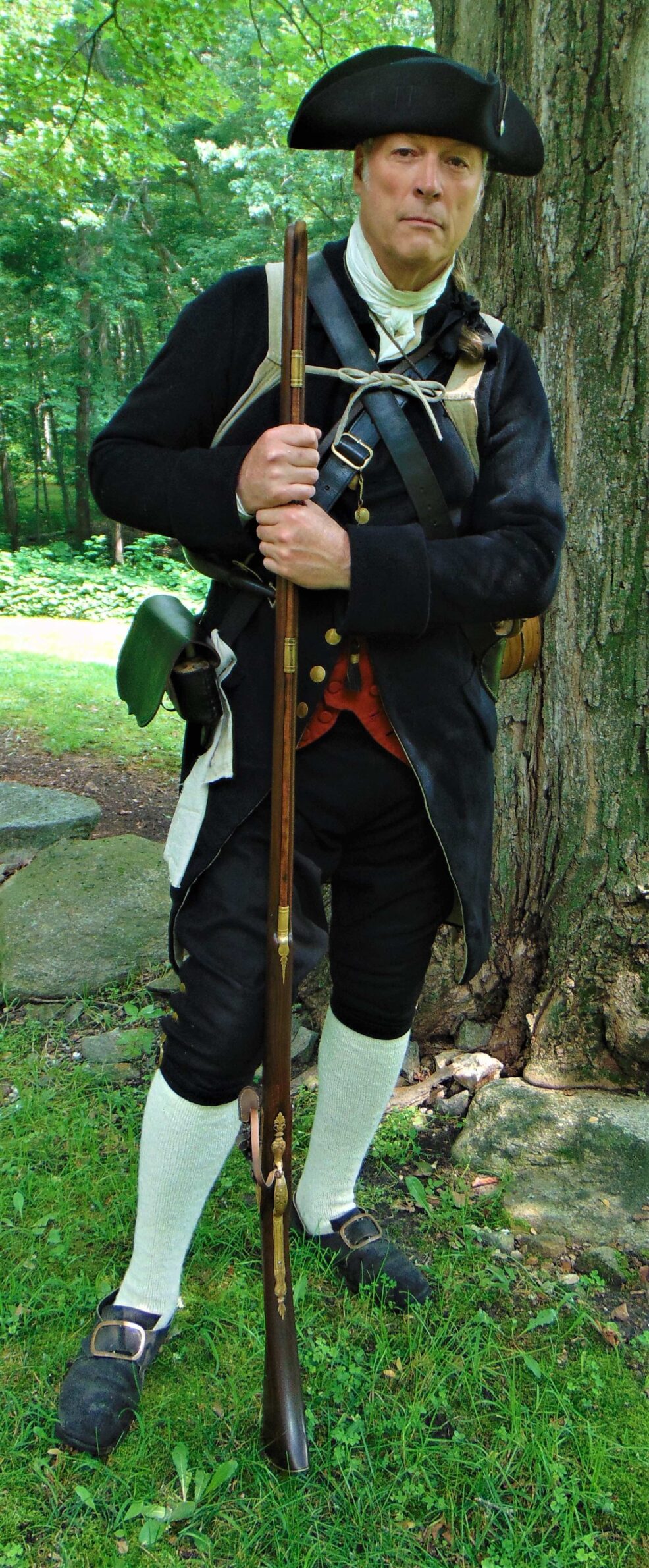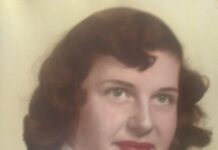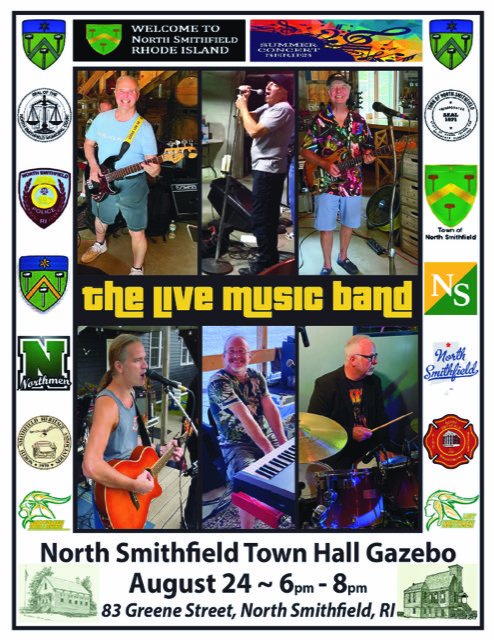
GLOCESTER – Glen Siner not only teaches history, he lives it.
Siner, a Glocester native has taught history for more than 30 years, the last 25 at Burrillville High School. But he has also been a historical reenactor with the Captain William Tew’s Company of the 2nd Rhode Island Regiment, a group that reenacts battles and skirmishes with the British during this country’s Revolutionary War in the 1700s, for the last 15 years.
“I’ve always been drawn to the story of the revolution,” said Siner, 65.
His interest in taking his passion for history to the next level began during a visit to Sturbridge Village, where he witnessed a reenactment group performing a battle. With the flag unfurled, the guns blazing, smoke rising from the scene and the cries of battle, he says he was immediately captured by the whole scene.
“I felt like a little kid,” Siner recalled.
Siner did his due diligence, researching the group to find out the details of what was involved and notes he even, “stalked,” a number of their encampments and battle sites. He was hooked. Shortly after, he signed up.
He says it was, “one of the best decisions I ever made in my life.”
Steeped in the events and history of the 1700s as a history teacher and an admitted history. “geek,” going back in time seemed natural to him.
“I think I was born in the wrong century,” he said with a laugh. “When I put on my Revolutionary costume, I’m still myself, but I am more like myself. When I go into the tent to put my costume on, I’m in the 21st Century. When I come out, I’m in the 18th Century.”
Actually, being a serious reenactor requires more than just a little preparation. Knowing the history is one thing; living it accurately is something else. All of his clothes, from shoes to head gear, are meticulously handmade, hand sewn according to the times. Show up at muster with a watch on, and you will get dressed down accordingly.
Siner explained that there are tailors, shoemakers and the like around New England who specialize in creating Revolutionary gear and clothing. And, yes, despite the heat, reenactors show up in full gear, just as their Colonial ancestors did, including muskets. Siner’s rifle serves several uses, depending on the shot used. There are lead balls for the battlefield, small shot for game and heavier shot for hunting. And while no actual ammo is used on the battlefield, the sound of muskets firing, guns literally blazing and smoke rising can send shivers up the backs of the staunchest.
Sleeping under the stars on the ground with no modern day advantages adds to the experience to a certain extent. If it rains, it rains.
“That is something they did 24/7, 365 days of the year,” said Siner. “We do it for 48 hours.”
Encampments add to the experience. Just as they did in the 1700s, reenactors might take a bit of rum and wander between encampments, sharing stories and experiences along with historical knowledge. Most, said Siner, are well versed in the historical details of the time and are more than willing to share that knowledge.
“Going from camp to camp, everyone around the fire, people (are) singing 18th Century songs. I really think it’s the people that make it what it is,” said Siner. “It becomes a community in and of itself. There is a real camaraderie that develops. We are history geeks. We all love to talk about history, swap information, etc.”
Siner has been to a variety of reenactments on historical sites, including battlefields, up and down the East Coast. At a reenactment in Quebec several years ago, more than 50,000 spectators showed up to witness the event. Still on his to-do list is the Battle of Yorktown.
“All of them have something to offer,” he said.
One of Siner’s favorite reenactments is the Boston Massacre, along with the Concord and Lexington battles. He recalled feeling like he had literally gone back in time as some, “battles,” have commenced. He says it is not an unusual feeling as a reenactor.

“I’ve stood behind a stone wall along Battle Road in Lexington where they stood, I’ve walked the battlements of Fort Ticonderoga on a starlit sky and watched the moon reflecting on Lake Champlain,” he recalled. “I’ve fired my musket until it is too hot to hold on the Monmouth Battlefield right on the spot where the Rhode Islanders fought back in 1778 and thought to myself with the sweat pouring into my eyes, and the smoke stinging my eyes and thought myself to be the luckiest man in the world to being doing that at that moment. Once you have experienced that, you can’t imagine not having that in your life.”
In essence the reenactors are making history come alive, drawing thousands of spectators at times to their events.
That approach, he said, is something he has also tried to do over the years as a teacher. In the past, Siner, who was a 1998 Burrillville High Teacher of the Year, has been recognized for his talents and creativity in teaching history. He and his students created a Nipmuc village behind the school along the river that runs there, replete with historically accurate handmade fish traps, dwellings and other elements that would have been part of the culture. The village was officially recognized by the Nipmuc Tribe officials at the time. He also created a mock, “dig,” in the courtyard of the school where students went about exploring the, “remains,” of a historical site, gridding it accordingly, just as modern day archeologists would do. Students were assigned squares to explore carefully, where hidden relics might be found to be catalogued and investigated for research.
“I think it is important to make history come alive,” said Siner. “Every once in awhile, you catch lightning in a bottle.”
Siner, who admitted he may retire at the end of the upcoming school year, said it is tough being a Continental soldier as he gets older. He has been a militia man now for awhile. A Continental soldier, who would be full time, might march from Concord to Boston, for example, while a militia man, a volunteer, would be someone like a local farmer who would show up to support troops, etc. close to home, then go back to his livelihood. On the other hand, said Siner, he might do well to take up the role of a shopkeeper. Naturally, he has done the research.
“These shopkeepers, Thurber and Cahoon, ran a store in Providence in the 1760s-80s,” explained Siner. “When I feel like I can’t keep up anymore, that would be a way to still be a part.”
But, he adds, he will continue to be a militia man for now.
“I am still in the wheelhouse for that,” he said. “The last man killed from Connecticut during the War was Phinias Meigs, who was 73. He was a militia man. I figure if old Phinias can hang in there that long, so can I.”









An incredible and passionate teacher at BHS during my time working there as well as a supportive colleague and all round nice person. He has left his mark on that high school and on many of his students and colleagues like me. He should be given much acclaim for his dedication and professionalism!! All my Best Glenn!!
A wonderful and impactful teacher, in and out of the classroom. Proud to know Mr. Siner and grateful for his time with 3 of my children at BHS.